Art Across Cultures Final
1/25
Earn XP
Description and Tags
(a) how these works treat issues of Indigenous identity, (b) how these works treat issues of Black identity, (c) how these works treat women’s issues, (d) how these works treat issues of labor and class.
Name | Mastery | Learn | Test | Matching | Spaced |
|---|
No study sessions yet.
26 Terms

Quilting Frolic
by John Lewis Krimmel
1813
Quilting Frolic by John Lewis Krimmel, 1813, is a painting celebrating early domestic life and the emerging national identity. It also reveals the racial hierarchies of the time, depicting all the black people in roles of servitude.
Quilting Frolic by John Lewis Krimmel is an early example of American genre painting that celebrates domestic life and emerging national identity through patriotic imagery. However, it also reveals the racial hierarchies of the time by depicting caricatured Black figures in subservient roles, reflecting the social tensions of early 19th-century America.

Cinqué
by Nathaniel Jocelyn
1839
Cinque by Nathaniel Jocelyn, 1839, is a powerful portrait of an abolition leader, portraying him with dignity and strength to garner support for abolition. It challenges prevailing racial stereotypes by portraying a black man as heroic and intelligent.
Cinqué by Nathaniel Jocelyn is a powerful portrait of the leader of the Amistad revolt, portraying him with dignity and strength to garner support for the abolitionist cause. The painting challenged prevailing racial stereotypes by presenting a Black man as a heroic and intelligent figure during a time of intense slavery debates in America.
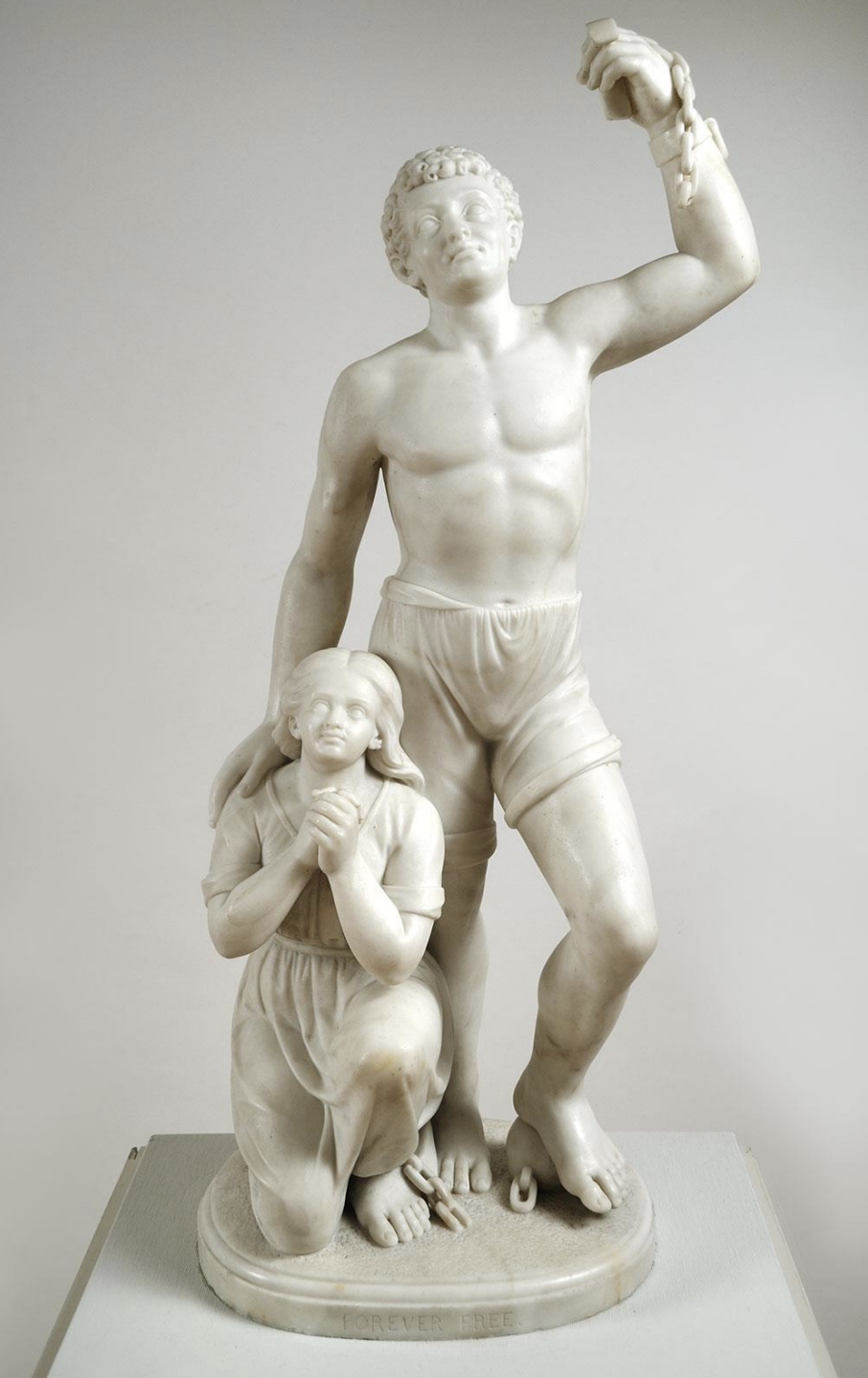
Forever Free (Morning of Liberty)
by Edmonia Lewis
1867-68
Forever Free by Edmonia Lewis, 1867, is a sculpture celebrating the freeing of enslaved people. It is a rare representation of black freedom and resilience through the use of idolized European figures.
Forever Free (Morning of Liberty) by Edmonia Lewis is a sculpture celebrating the emancipation of enslaved people, created by a Black female artist shortly after the Civil War. It holds significance for its rare representation of Black freedom and resilience, while also reflecting the limitations of its time through its idealized, Europeanized figures.
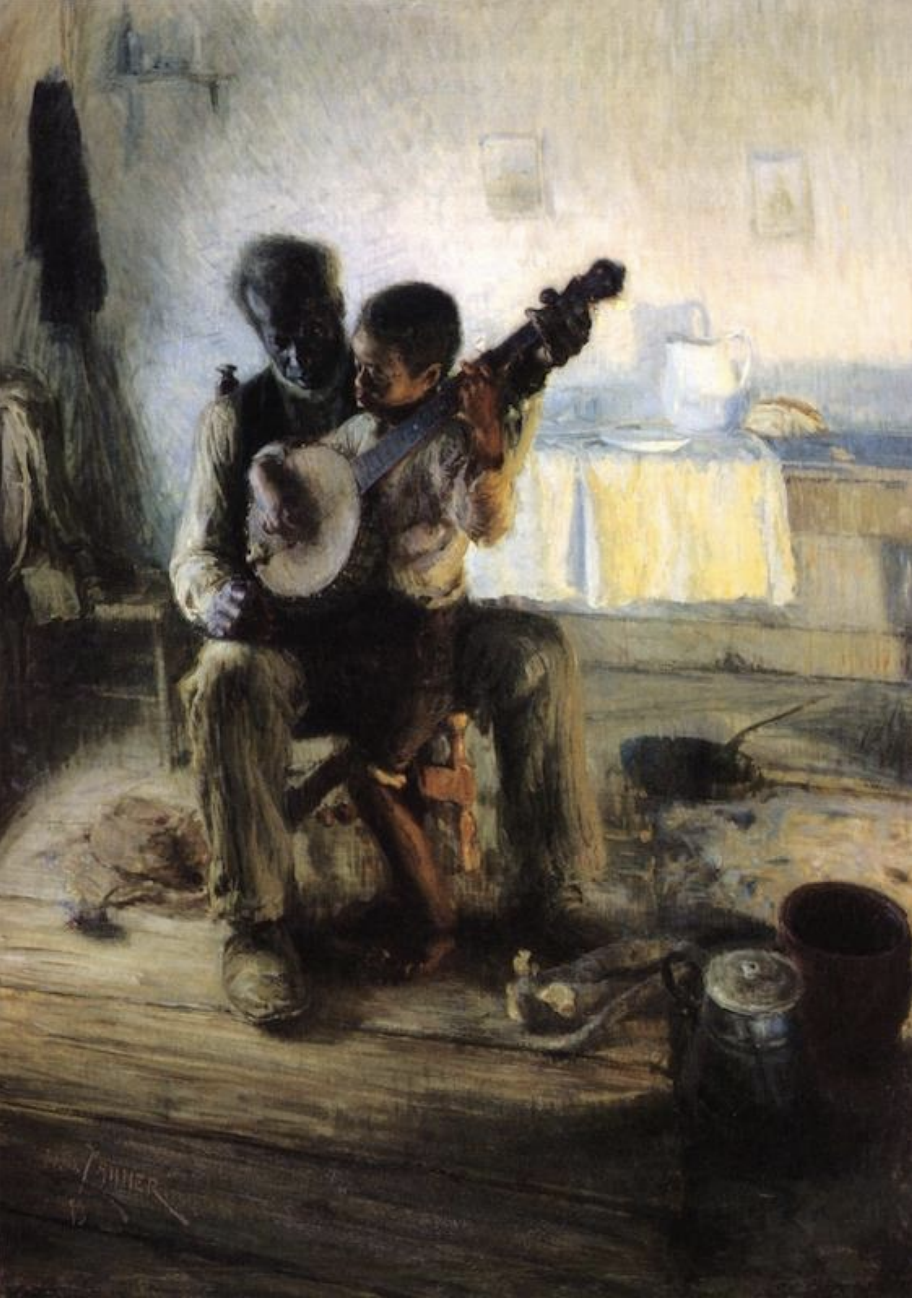
The Banjo Lesson
by Henry Ossawa Tanner
1893
The Banjo Lesson by Henry Ossawa Tanner, 1893, is a painting portraying an intimate moment between an elderly man and a child, countering racial stereotypes of the time. It humanizes black life, while emphasizing education and heritage in a time of widespread discrimination.
The Banjo Lesson by Henry Ossawa Tanner is a landmark painting that portrays an intimate, dignified moment between an elderly man and a child, countering racist stereotypes of African Americans. Its relevance lies in its humanizing depiction of Black life, emphasizing education, heritage, and quiet strength during a time of widespread discrimination.
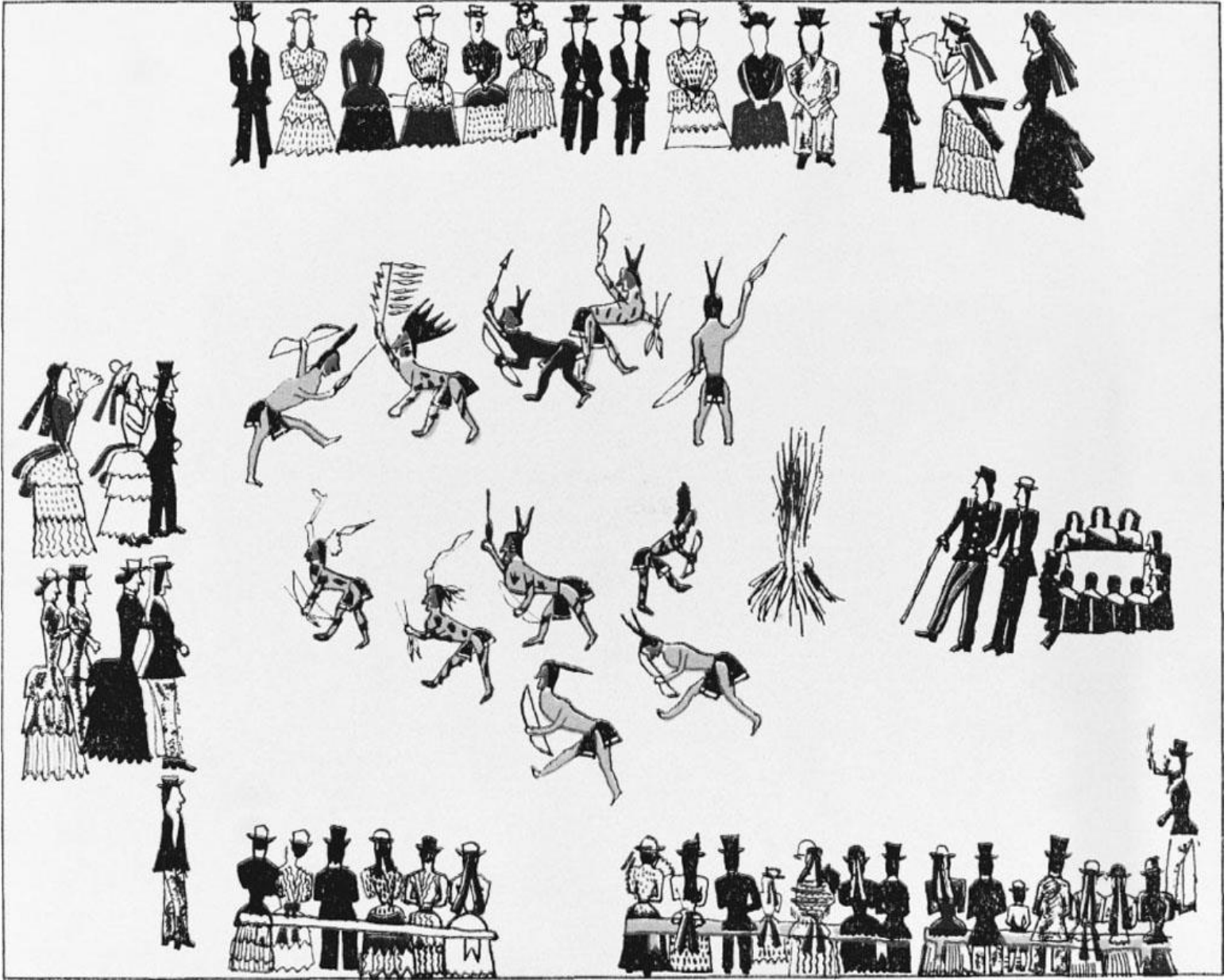
Fort Marion Prisoners Dancing for Tourists
by Cohoe
1875-77
Fort Marion Prisoners Dancing for Tourists by Cohoe, 1875, highlights forced assimilation and performance imposed upon Native American prisoners. It is an important documentation of how indigenous traditions were suppressed and commoditized under US rule.
Fort Marion Prisoners Dancing for Tourists by Cohoe highlights the forced assimilation and cultural performance imposed on Native American prisoners held at Fort Marion in the late 19th century. The drawing is relevant for documenting how Indigenous traditions were both suppressed and commodified under U.S. colonial policies, revealing the complexities of resistance and survival.
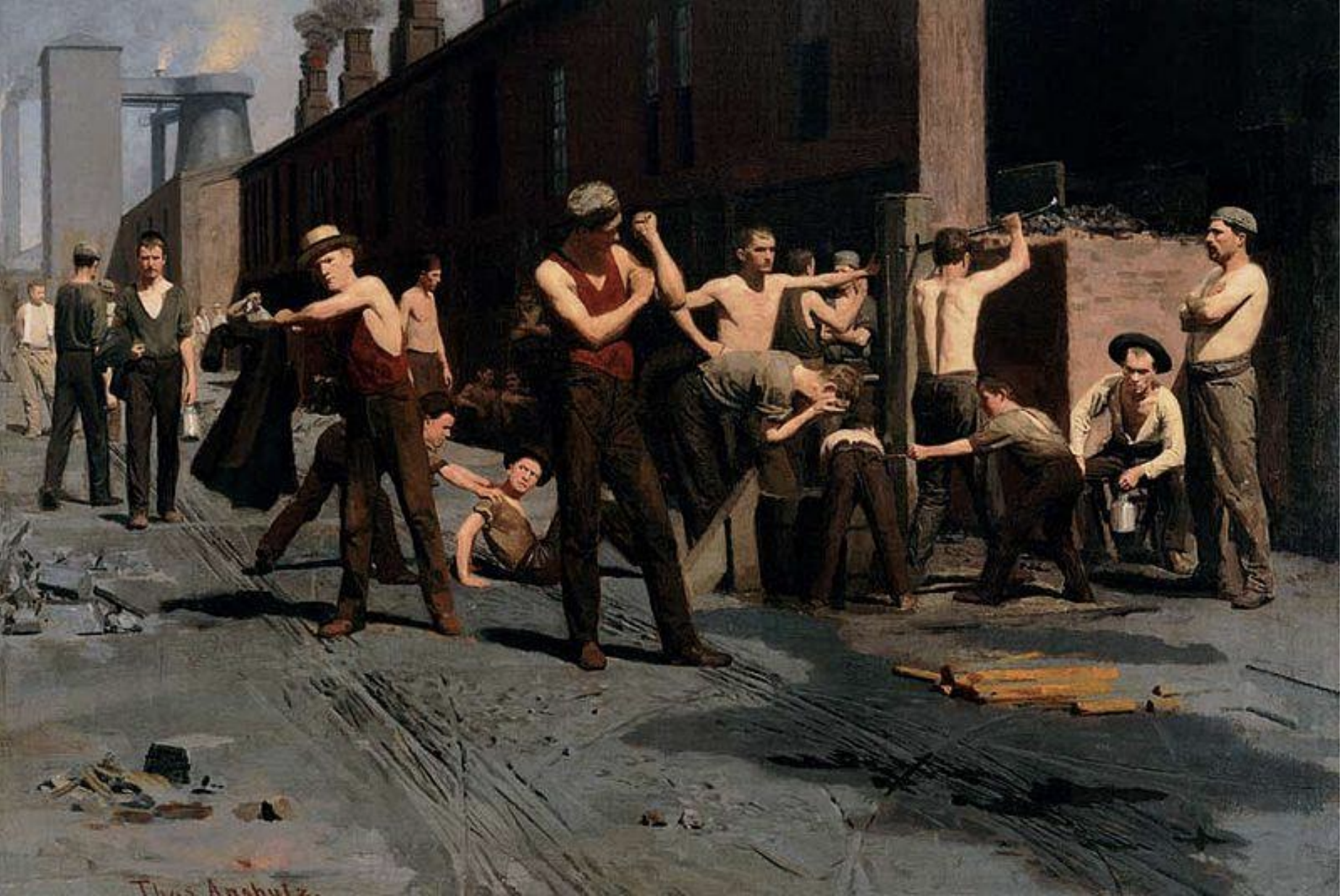
The Ironworkers’ Noontime
by Thomas Pollock Anshutz
1880
The Ironworker’s Noontime by Thomas Pollock Anshutz, 1880, captures industrial workers during a rare time of rest, offering a realistic glimpse into the harsh realities of laborers. This is the start of a shift towards socially conscious art with realism and empathy.
The Ironworkers’ Noontime by Thomas Pollock Anshutz captures industrial workers during a rare moment of rest, offering an unromanticized glimpse into the harsh realities of labor in the late 19th century. Its relevance lies in its early depiction of the American working class with realism and empathy, marking a shift toward socially conscious art.

Meeting the Molly Maguire Men
by Paul Frenzeny & Jules Tavernier
in Harper’s Weekly
1874
Meeting the Molly Maguire Men by Paul Frenzeny, 1874, illustrates a secretive meeting linked to labor struggles of Irish coal miners in the 19th century. It depicts the tension between the labor movement and industrial powers, as well as fears surrounding immigrant workers.
Meeting the Molly Maguire Men by Paul Frenzeny and Jules Tavernier illustrates a secretive moment linked to the labor struggles of Irish-American coal miners in the 19th century. The image is relevant for its depiction of the tension between labor movements and industrial power, as well as the xenophobic fears surrounding immigrant workers at the time.
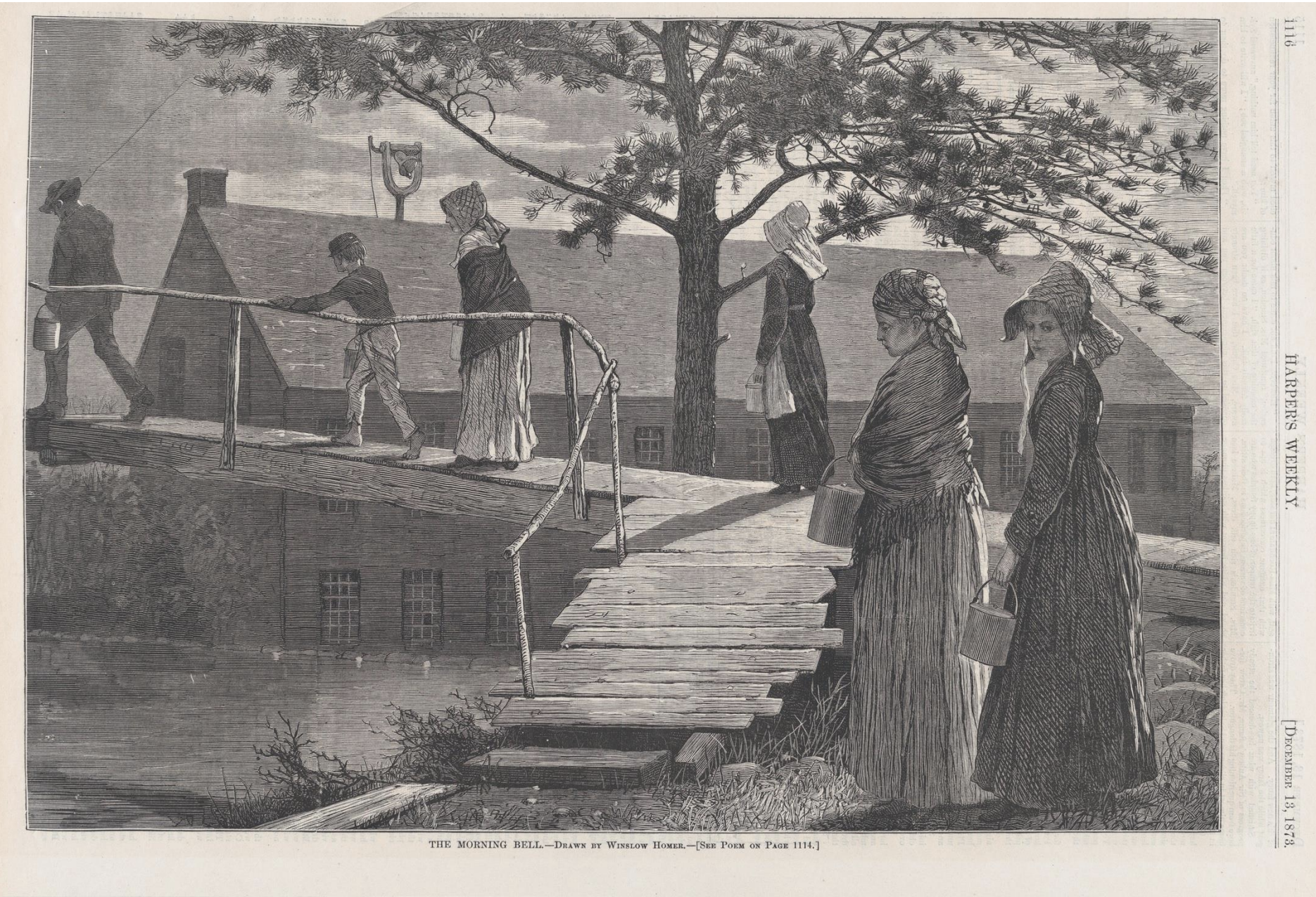
The Morning Bell in Harper’s Weekly
by Winslow Homer
1873
The Morning Bell by Winslow Homer, 1873, reflects upon the growing presence of women in the workforce. It highlights both the opportunity and exploitation of women during industrialization.
The Morning Bell by Winslow Homer, published in Harper’s Weekly, depicts young women entering a textile mill, reflecting the growing presence of women in industrial labor during the 19th century. Its relevance lies in highlighting the intersection of gender, labor, and industrialization, capturing both opportunity and exploitation in the changing American workforce.
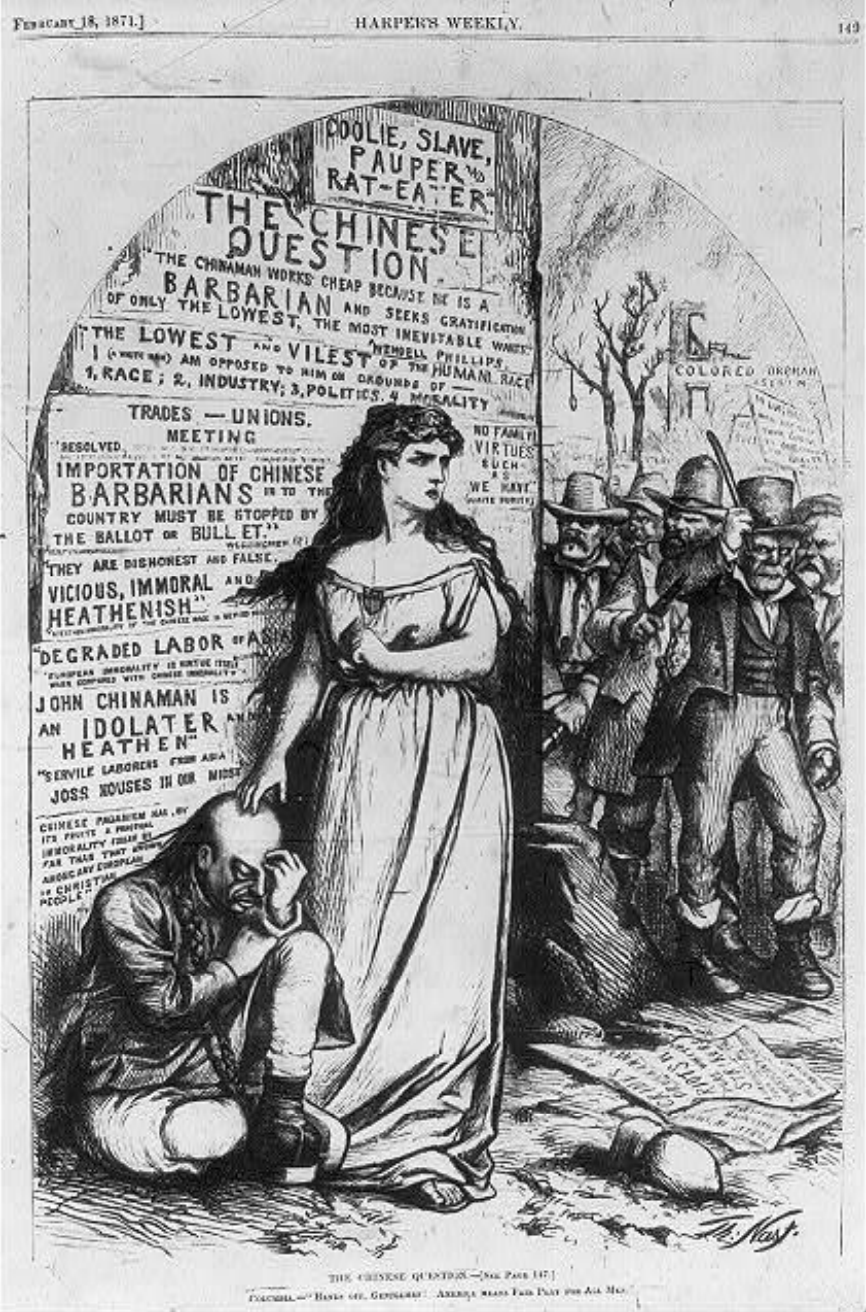
The Chinese Question
by Thomas Nast
in Harper’s Weekly
1871
The Chinese Question by Thomas Nast, 1871, is a political cartoon defending Chinese immigrants. It uses satire to expose the hypocrisy of discrimination and advocate for equal rights during rising anti-Chinese sentiment.
The Chinese Question by Thomas Nast is a political cartoon that defends Chinese immigrants amid rising anti-Chinese sentiment and exclusionary policies in 19th-century America. Its relevance lies in its rare stance of empathy, using satire to expose the hypocrisy of discrimination and advocate for equal rights during a period of intense xenophobia.
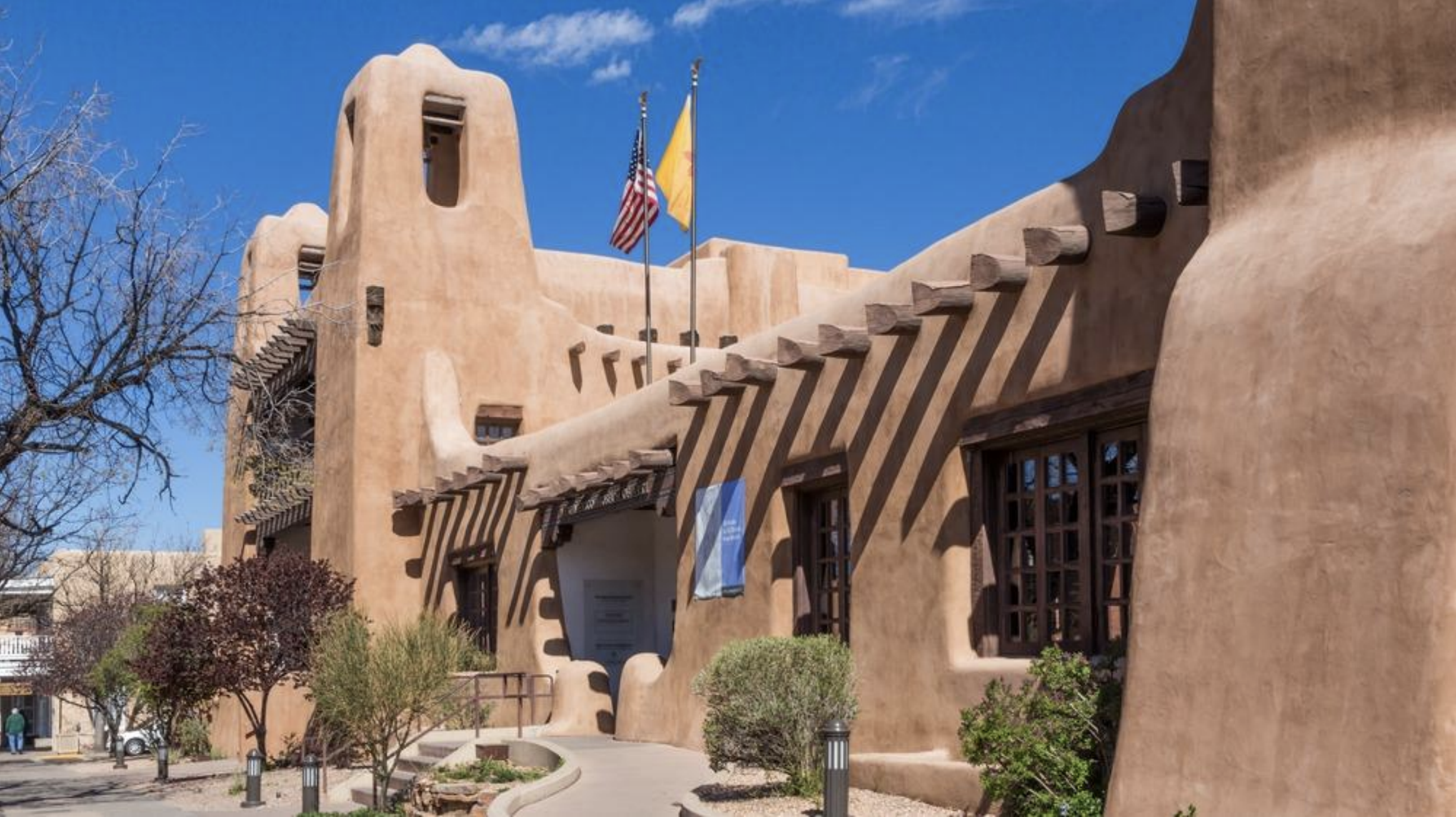
New Mexico Museum of Art
Santa Fe
1917
The New Mexico Museum of Art in Santa Fe NW, 1917, is a key institution for preserving and showcasing the region’s cultural heritage and art. It is a center for artistic exploration and education.
The New Mexico Museum of Art in Santa Fe is a key institution for preserving and showcasing the region's unique cultural heritage, including Native American, Hispanic, and contemporary art. Its relevance lies in its role as a major hub for artistic exploration, offering a deep connection to the history and evolving identity of New Mexico through visual arts.
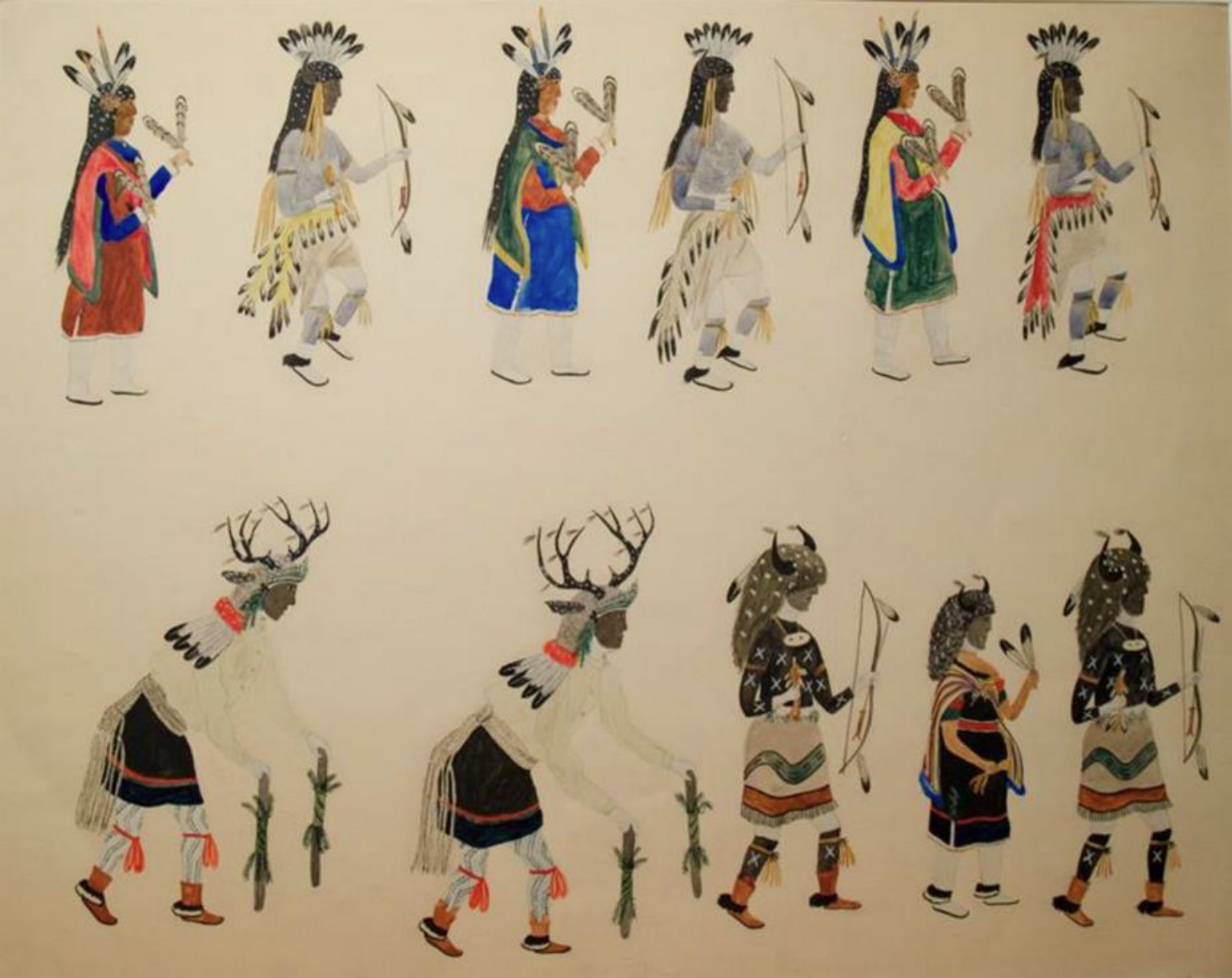
Eleven Figures of Animal Dance
by Crescencio Martínez (Tewa, San Ildefonso Pueblo)
1918
Eleven Figures of Animal Dance by Crescencio Martinez, 1918, is a pivotal Native American artwork depicting the San Ildefonso Pueblo dance. This painting is in an “ana-ethnographic” style, depicting parts of a dance while withholding important info to resist exploitation.
Crescencio Martínez's Eleven Figures of Animal Dance (1918) is a pivotal work in early 20th-century Native American art, illustrating the winter dance at San Ildefonso Pueblo. This painting exemplifies the "ana-ethnographic" approach, where Martínez selectively depicted public ceremonial dances for outsider audiences while withholding sacred knowledge, thereby navigating and resisting ethnographic exploitation.
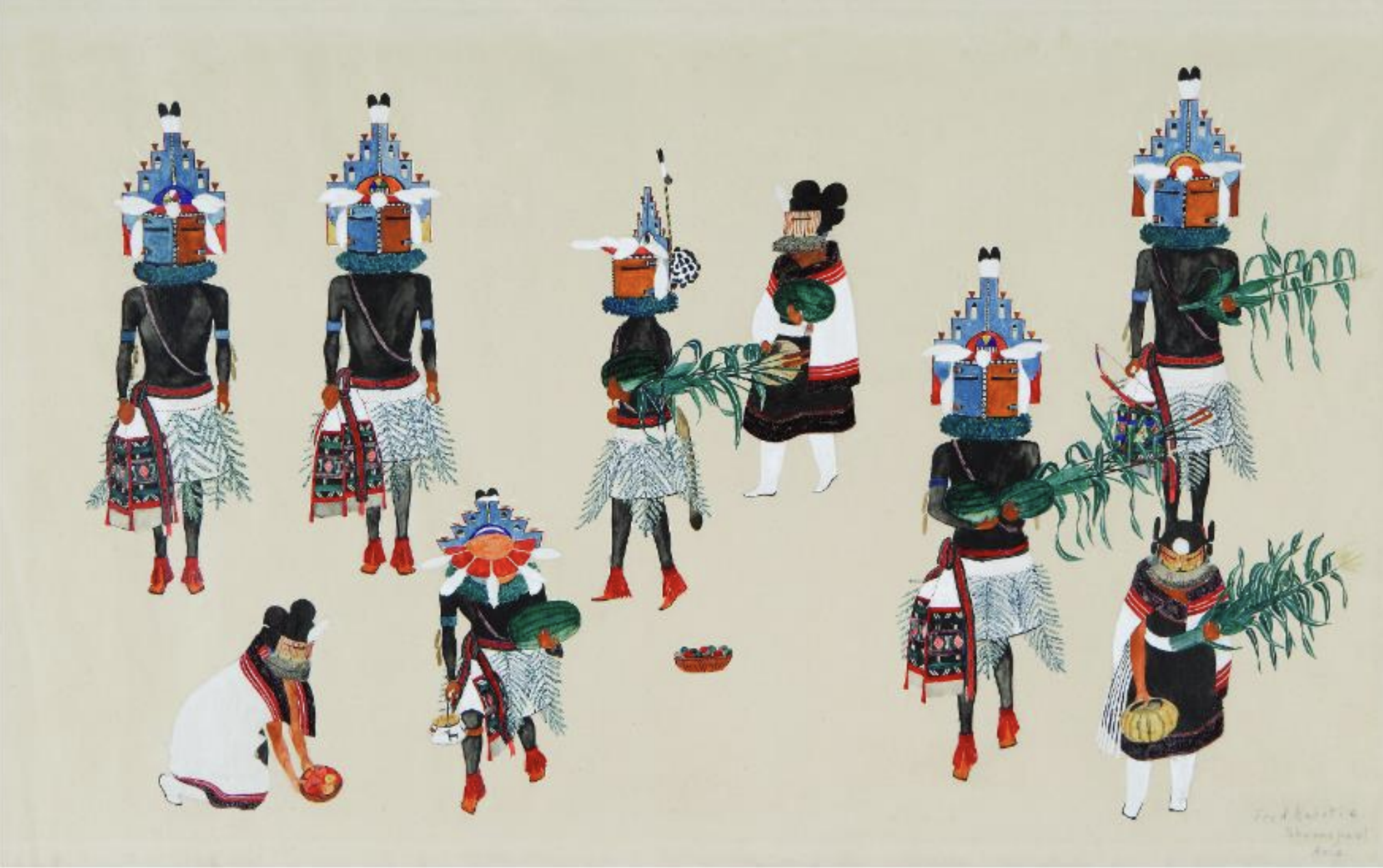
Niman Katchina Dance
by Fred Kabotie (Hopi)
1920
Niman Katchina Dance by Fred Kabotie, 1920, is a watercolor painting portraying a sacred Pueblo spiritual ceremony. This painting is notable due to its respect and accuracy for the culture, serving as a means of cultural preservation.
Fred Kabotie's Niman Kachina Dance (c. 1925–1930) is a significant watercolor that portrays the Hopi Niman Ceremony, a sacred ritual marking the departure of the katsinam (spiritual beings) from the pueblo. Kabotie's depiction is notable for its respectful and accurate representation of Hopi ceremonial life, serving both as an artistic record and a means of cultural preservation during a period of increasing external scrutiny and cultural appropriation.
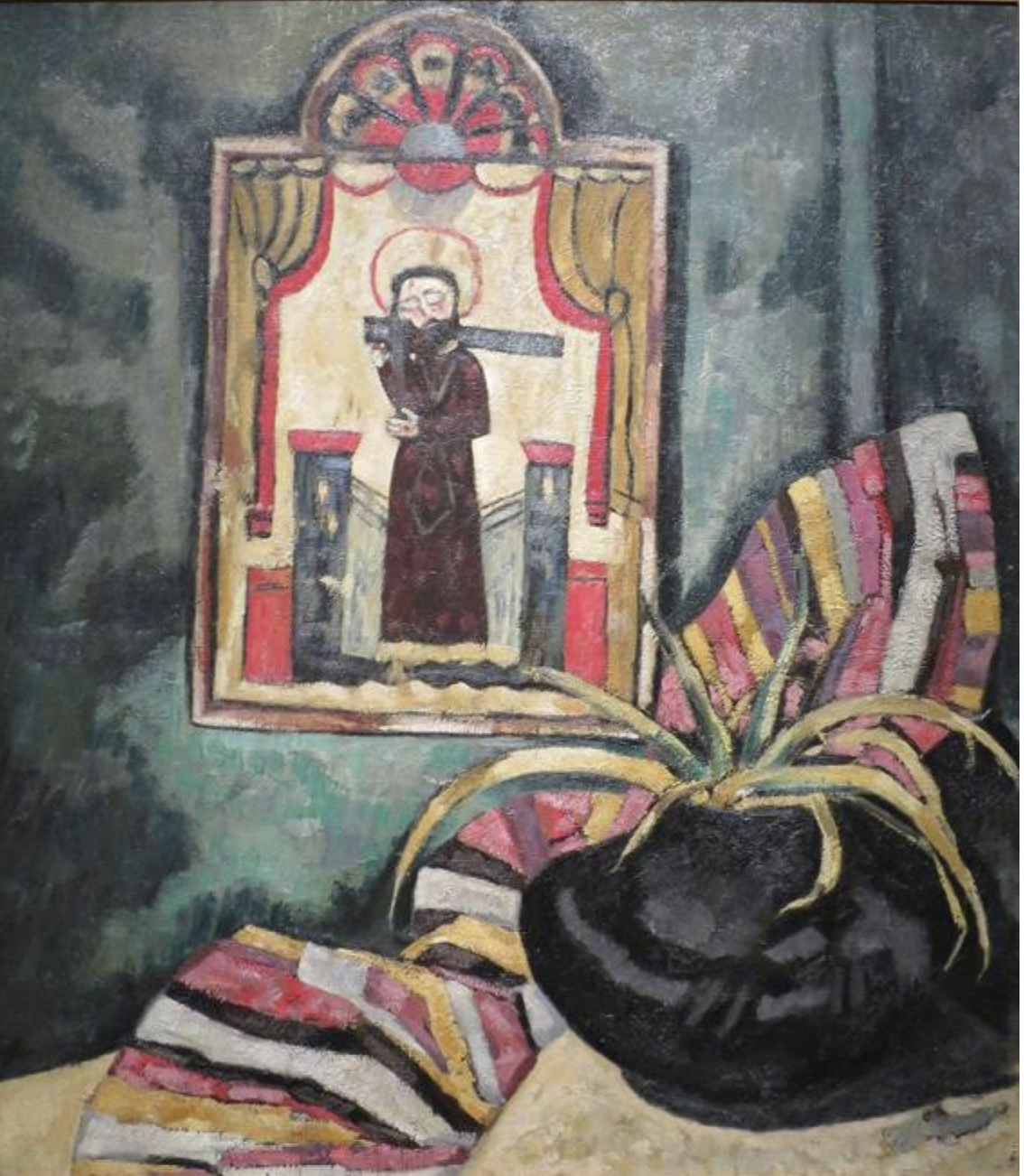
El Santo
by Marsden Hartley
1919
El Santo by Marsden Hartley, 1919, is a work that reflects the artist’s fascination with Mexican culture and spirituality. It captures both the sense of mysticism and personal connection while showing the artist’s exploration of color and form.
El Santo by Marsden Hartley is a significant work that reflects the artist's fascination with Mexican culture and spirituality during his time in Mexico in the early 20th century. Its relevance lies in its depiction of a Mexican religious figure, capturing both a sense of mysticism and personal connection, while showcasing Hartley's exploration of color and form influenced by his interest in folk art and symbolism.
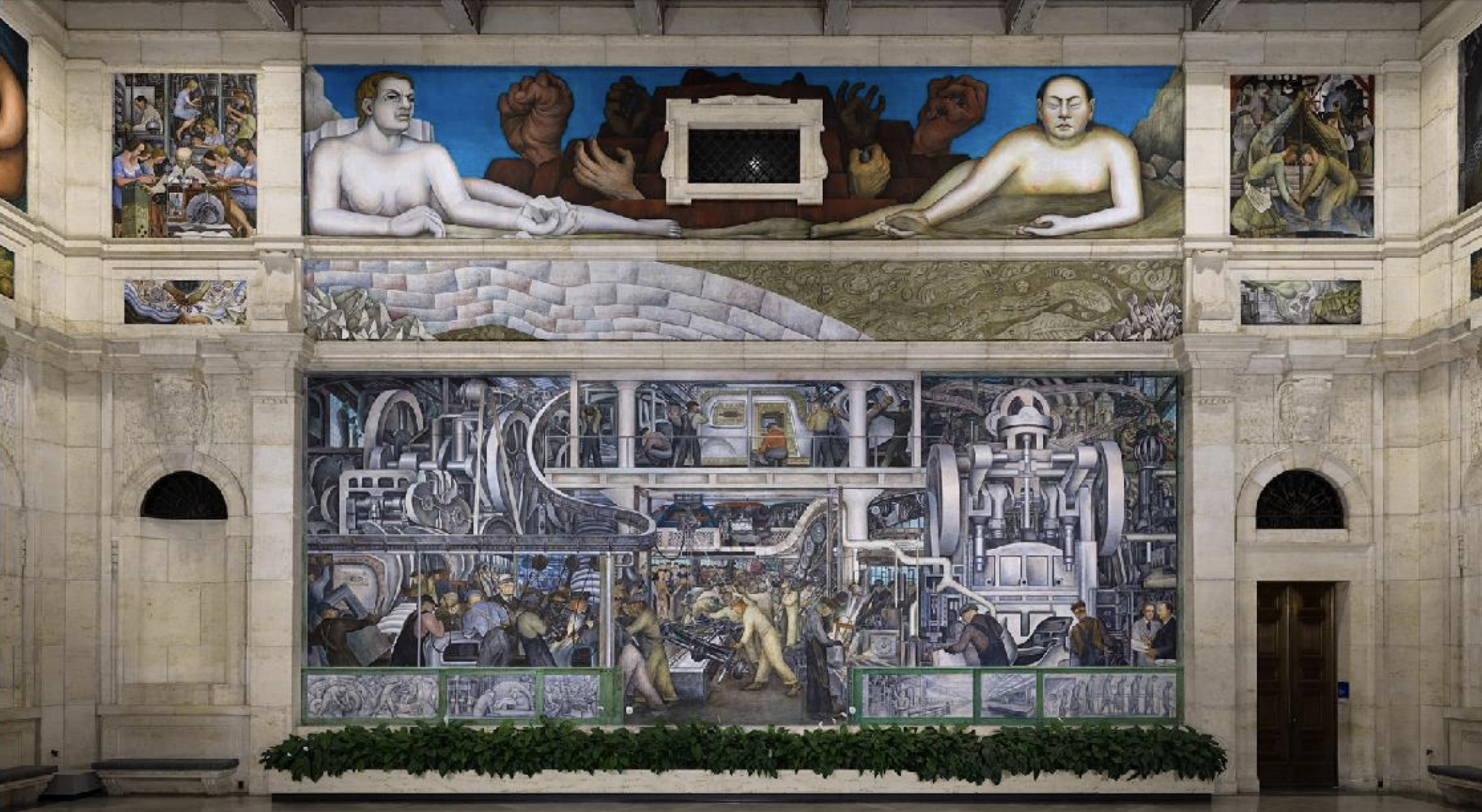
Detroit Industry (south wall)
by Diego Rivera
at Detroit Institute of the Arts
1932-33
Detroit Industry by Diego Rivera, 1932, is a renowned work of art that depicts the workers and machinery of the Ford Motor Company’s plant, celebrating industrialization. It combines rising social realism with Mexican muralism to convey a message about the dignity of labor and the complex relationships it comes with.
Detroit Industry (South Wall) by Diego Rivera is a renowned fresco that depicts the workers and machinery of the Ford Motor Company's Detroit plant, celebrating industrial labor and the power of modern production. Its relevance lies in its fusion of social realism and Mexican muralism, conveying a powerful message about the dignity of labor while also addressing the complex relationship between workers, technology, and capitalism.
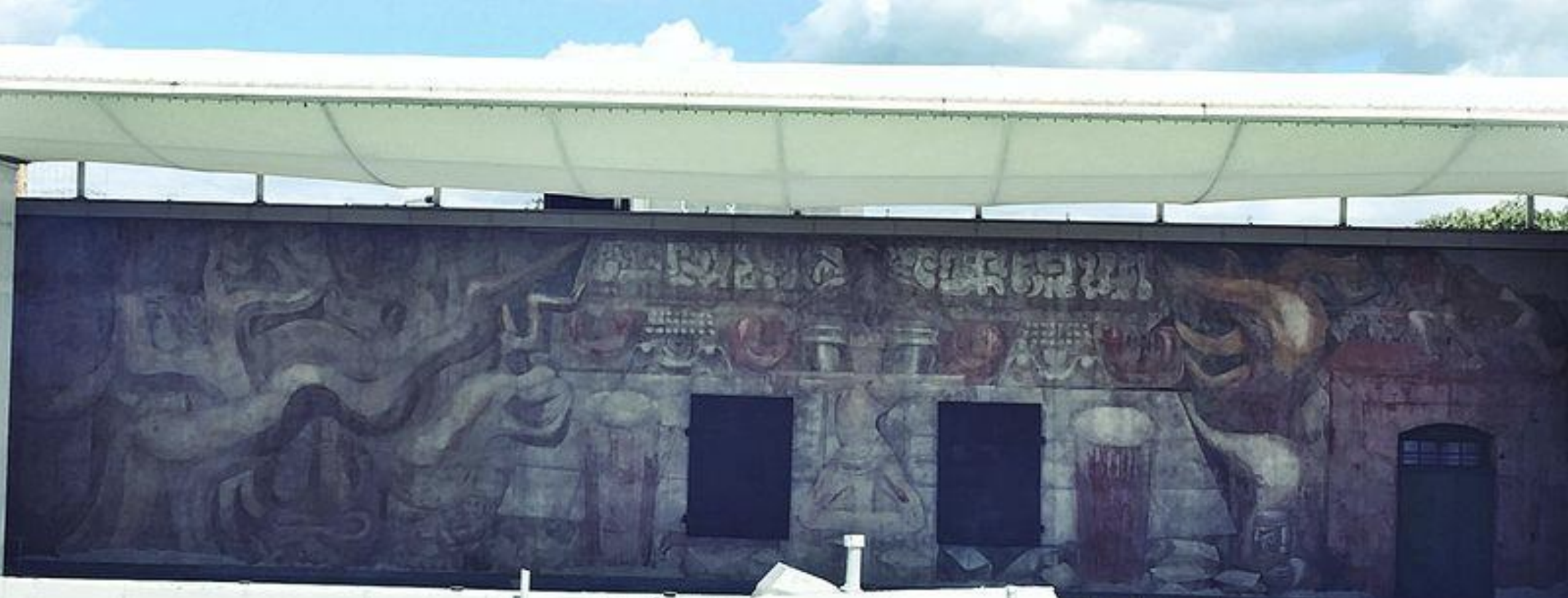
América Tropical
by Davíd Alfaro Siqueiros
Los Angeles, CA
1932
America Tropical by David Alfaro Siqueiros, 1932, is a political mural critiquing US imperialism and the oppression of indigenous people. It uses bold, vivid imagery to challenge popular narratives of the time and to advocate for social justice.
América Tropical by David Alfaro Siqueiros is a politically charged mural that critiques U.S. imperialism in Latin America, symbolizing the oppression of the indigenous people and the exploitation of the region's resources. Its relevance lies in its bold, vivid imagery and its role in pioneering social and political muralism, challenging dominant narratives and advocating for social justice.
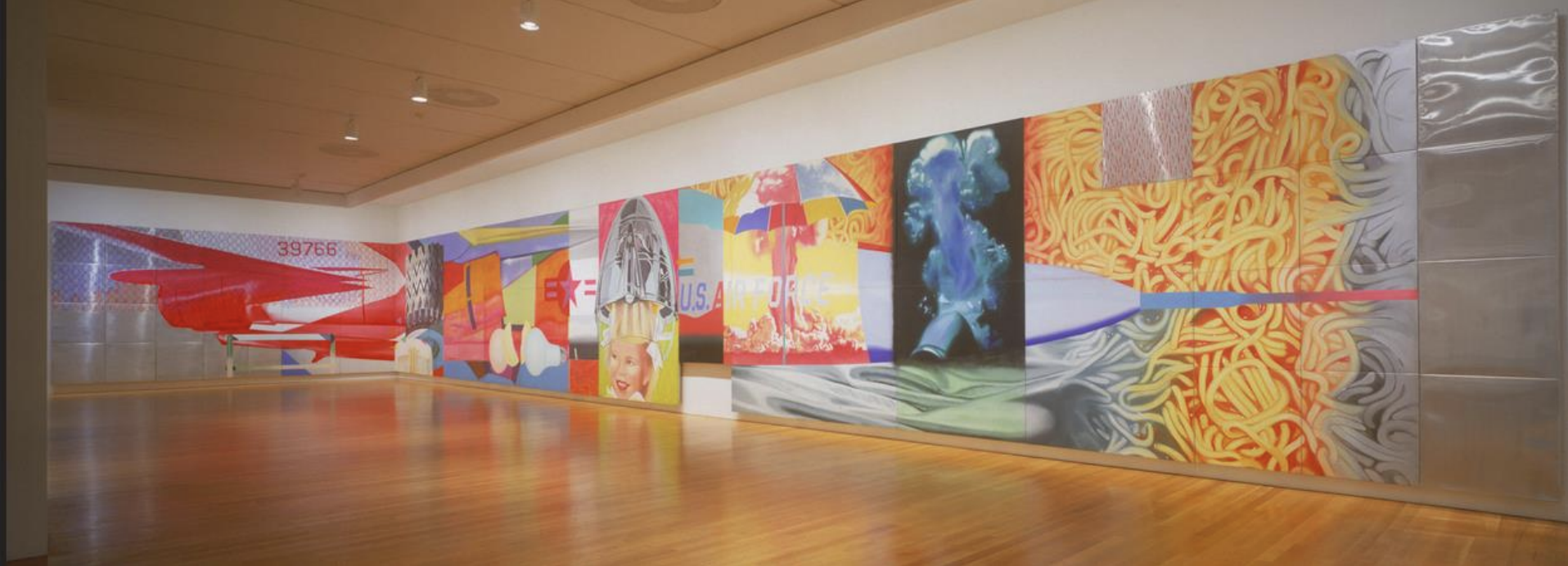
F-111
by James Rosenquist
1964-65
F-111 by James Rosenquist, 1964, is a painting that juxtaposes consumerism and military power in a collage style. It gives critical commentary on capitalism, war, and media, reflecting on Cold War anxieties while challenging traditional notions of art and politics.
F-111 by James Rosenquist is a large-scale pop art painting that juxtaposes consumerism, military power, and American consumer culture, using a fragmented, collage-like style. Its relevance lies in its critical commentary on the intersection of capitalism, war, and media, reflecting the anxieties of the Cold War era while challenging traditional notions of art and politics.
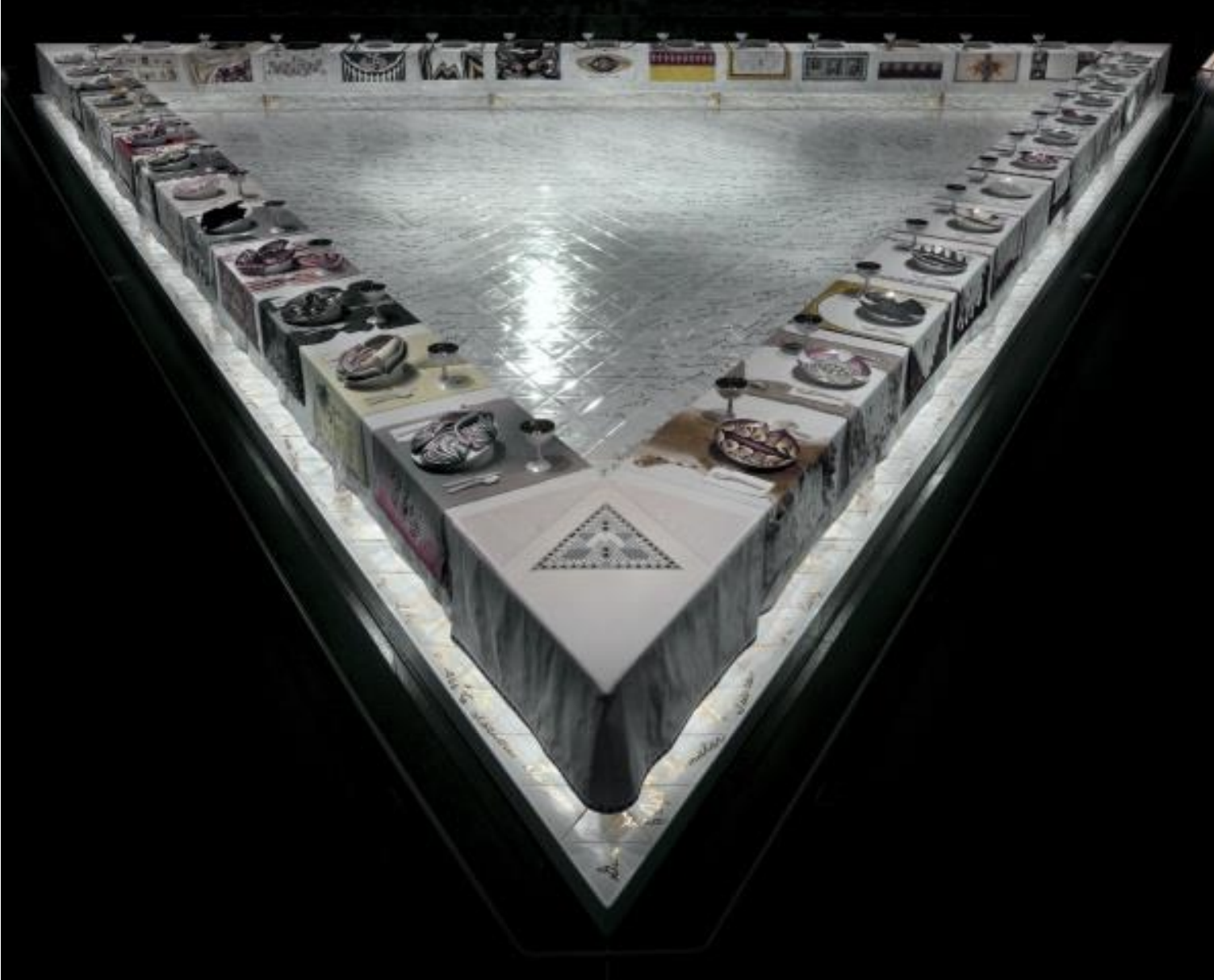
Dinner Party
by Judy Chicago
1974-79
Dinner Party by Judy Chicago, 1974, is an important feminist work that celebrates women’s history and achievements. It has 39 place settings each dedicated to a woman and their achievements, challenging the male dominated art world.
The Dinner Party by Judy Chicago is a landmark feminist artwork that celebrates women's history and achievements through a large, triangular table featuring 39 place settings, each dedicated to a significant woman. Its relevance lies in its challenge to the male-dominated art world and its role in redefining the representation of women in art, promoting both inclusivity and gender equality. Plates represent vulva/vaginal imagery. Only included one Latina and one person from the lgbtq+ community.
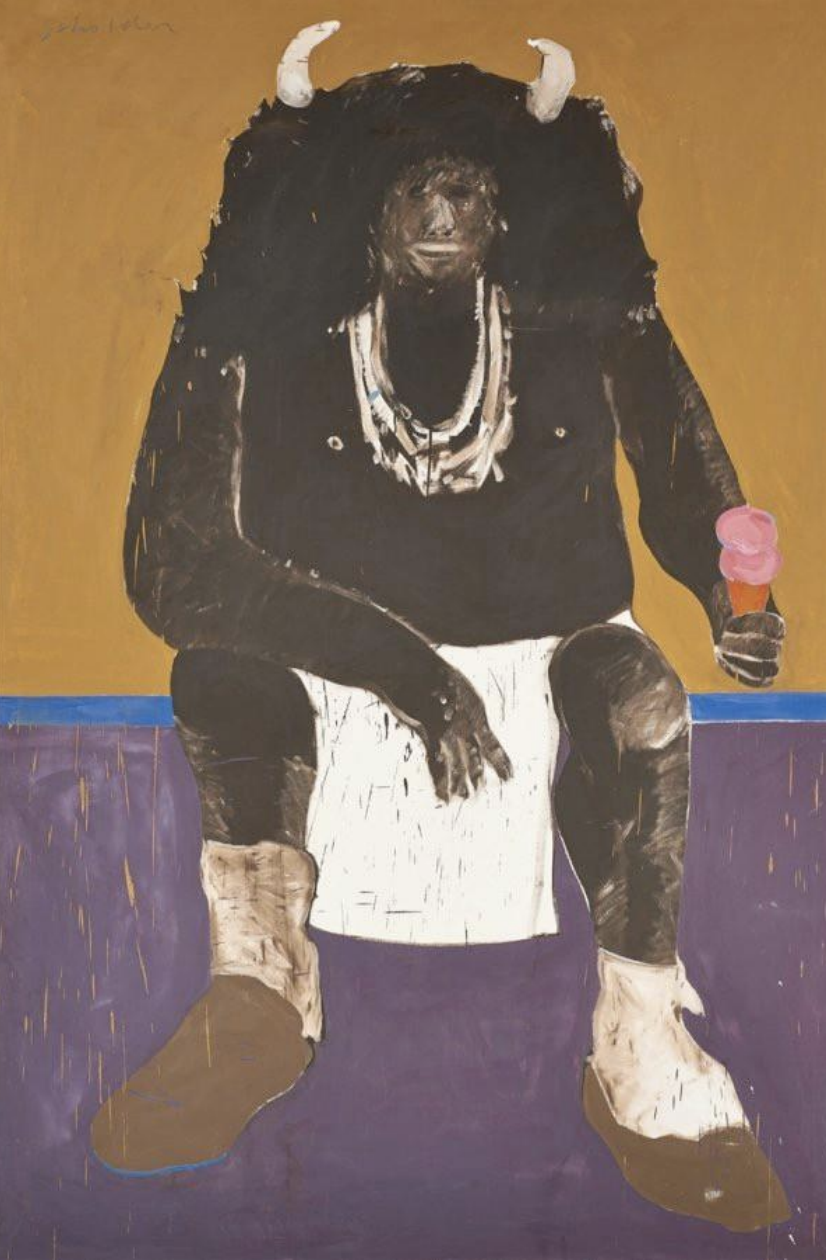
Super Indian no. 2
by Fritz Scholder
1971
Super Indian no 2 by Fritz Scholder, 1971, challenges stereotypical representations of Native Americans by depicting them in an exaggerated manner. It takes traditional Native American imagery and offers a complex identity that blends cultural pride with social perceptions.
Super Indian No. 2 by Fritz Scholder challenges stereotypical representations of Native Americans by depicting a figure in a modern, exaggerated, and heroic manner. Its relevance lies in its bold subversion of traditional Native American imagery, offering a complex, contemporary identity that blends cultural pride with a critique of societal perceptions.

A Remembered Muse (Tosca)
by T.C. Cannon
woodblock print
1978
A Remembered Muse by T.C. Cannon, 1978, is a painting that merges Native American and Western art, portraying an opera character with Native symbolism. It is able to fluently blend cultural references, challenging the traditional portrayal of Native Americans and their connections to high culture.
A Remembered Muse (Tosca) by T.C. Cannon is a vibrant painting that merges Native American and Western artistic traditions, portraying the figure of Tosca, a character from opera, with elements of Native American symbolism. Its relevance lies in its blending of cultural references, challenging both the traditional portrayal of Native Americans in art and the boundaries between high culture and indigenous identity.
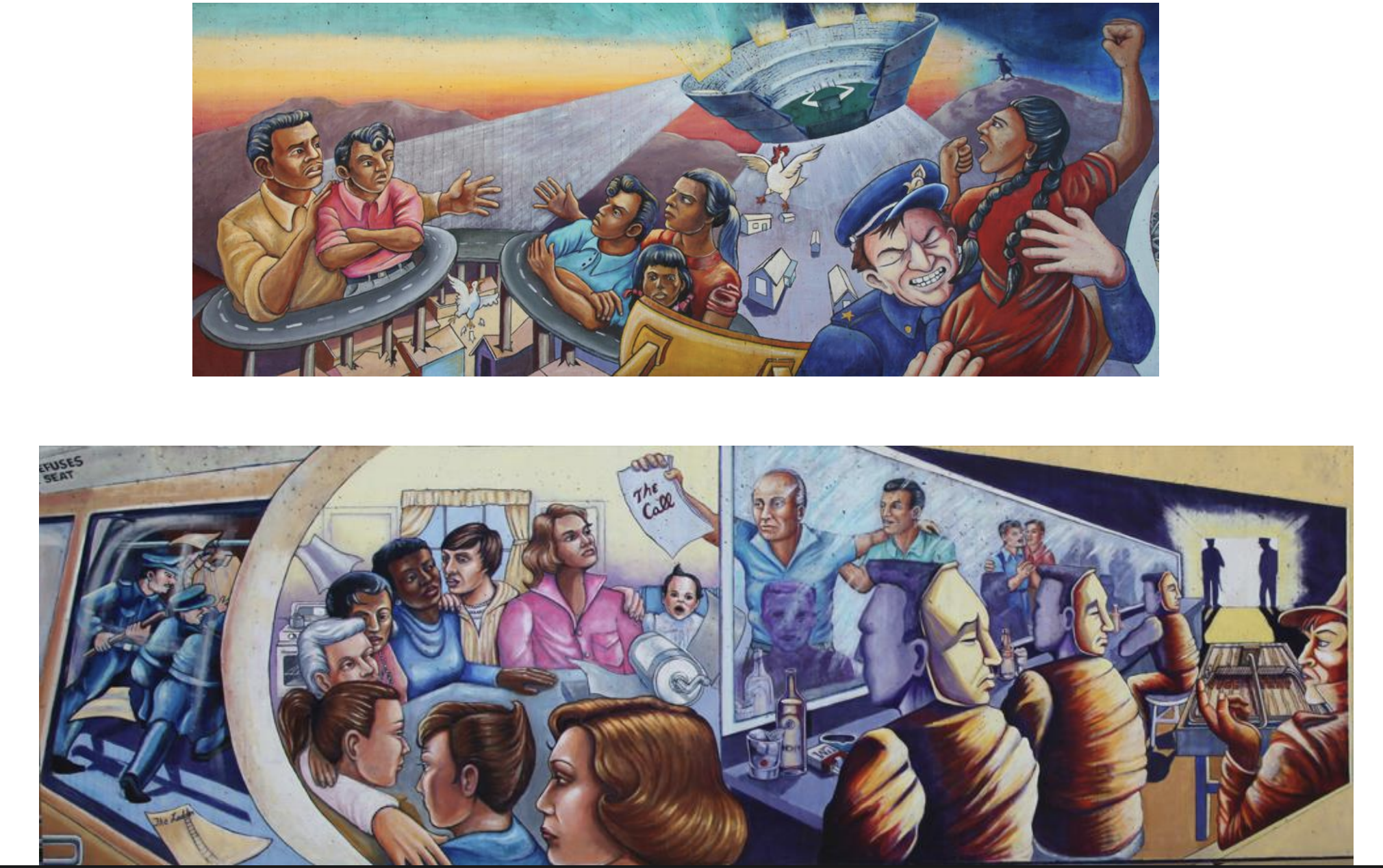
The Great Wall
by Judy Baca
Los Angeles, CA
1976-83
The Great Wall in LA by Judy Baca, 1976, is a monumental mural that tells the real history of California, addressing migration, social justice, and racial identity. It acts as a powerful example of community led art and the ability to challenge historical narratives.
The Great Wall by Judy Baca is a monumental mural that chronicles the history of California and its diverse communities, addressing themes of migration, social justice, and racial identity. Its relevance lies in its role as a powerful example of community-based art, using public space to empower marginalized voices and challenge historical narratives.
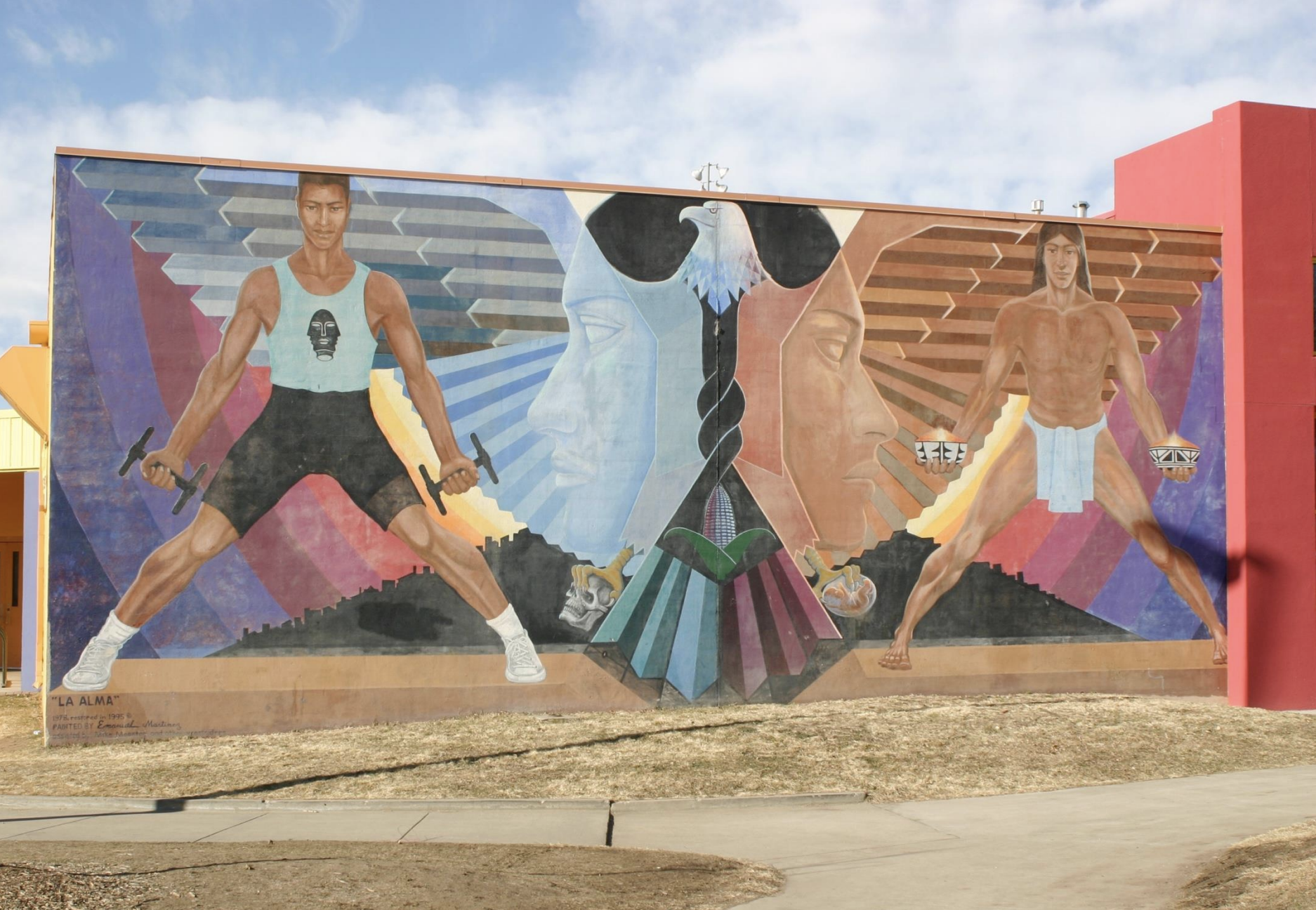
La Alma/The Soul
by Emanuel Martínez
Denver, 1977
The Soul in Denver by Emanual Martinez, 1977, is a mural reflecting the cultural and spiritual connection of Chicanos to their heritage. It blends indigenous and contemporary art to celebrate the Chicano identity, history, and resilience.
La Alma/The Soul by Emanuel Martínez is a mural that reflects the cultural and spiritual connection of Chicano communities to their heritage, blending indigenous and contemporary elements. Its relevance lies in its celebration of Chicano identity, history, and resilience, using art to express a collective sense of pride and resistance against cultural erasure.

Design/Execution of the Vietnam War Memorial
by Maya Lin
1980
The Vietnam War Memorial by Maya Lin, 1980, is significant for its minimalist design to create a somber and reflective space where visitors can connect with the loss of over 58,000 soldiers. Its design challenges traditional views of memorials, offering a more personal and emotional experience for the viewer.
The design submission for the Vietnam War Memorial, created by Maya Lin, is significant for its minimalist and poignant approach to honoring fallen soldiers, with the black granite walls engraved with over 58,000 names. Its relevance lies in its emotional and reflective design, which broke from traditional war memorials and sparked debates about the representation of grief, memory, and national trauma.
The Vietnam War Memorial by Maya Lin is a groundbreaking work that uses minimalist design to create a somber, reflective space where visitors can connect with the loss of over 58,000 American soldiers. Its relevance lies in how it challenges traditional monumental art, offering a deeply personal and emotional experience, while fostering healing and reconciliation for those affected by the war.
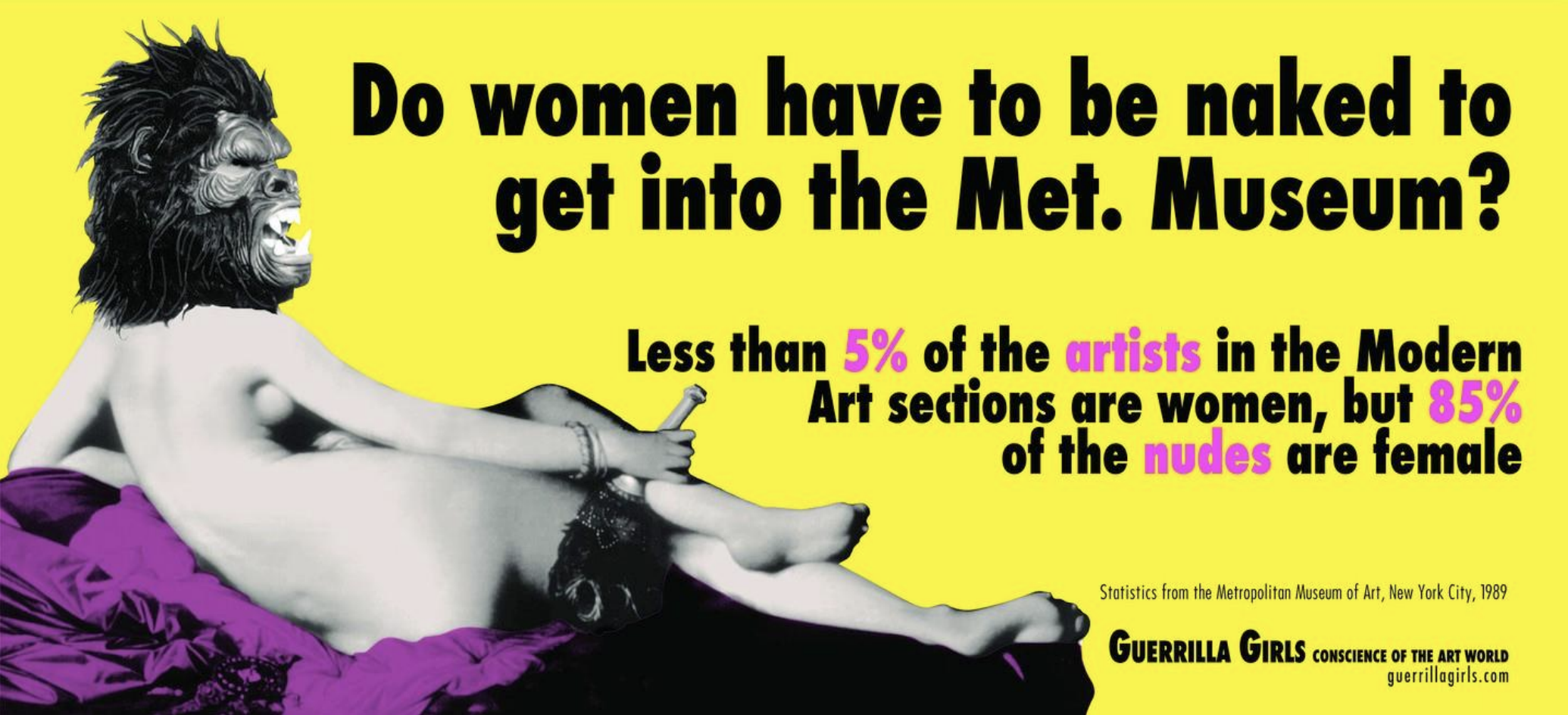
Guerilla Girls
1989
The Guerilla Girls, 1989, is an anonymous feminist art collective that uses posters and billboards to critique the art world’s gender and racial inequalities. They use a bold sense of humor to challenge institutional power and to raise awareness for equal representation in art.
The Guerrilla Girls are an influential feminist art collective that uses provocative posters, billboards, and performances to critique the art world’s gender and racial inequalities. Their relevance lies in their bold use of humor and anonymity to challenge institutional power, raise awareness about discrimination, and push for greater representation of women and people of color in the art world.
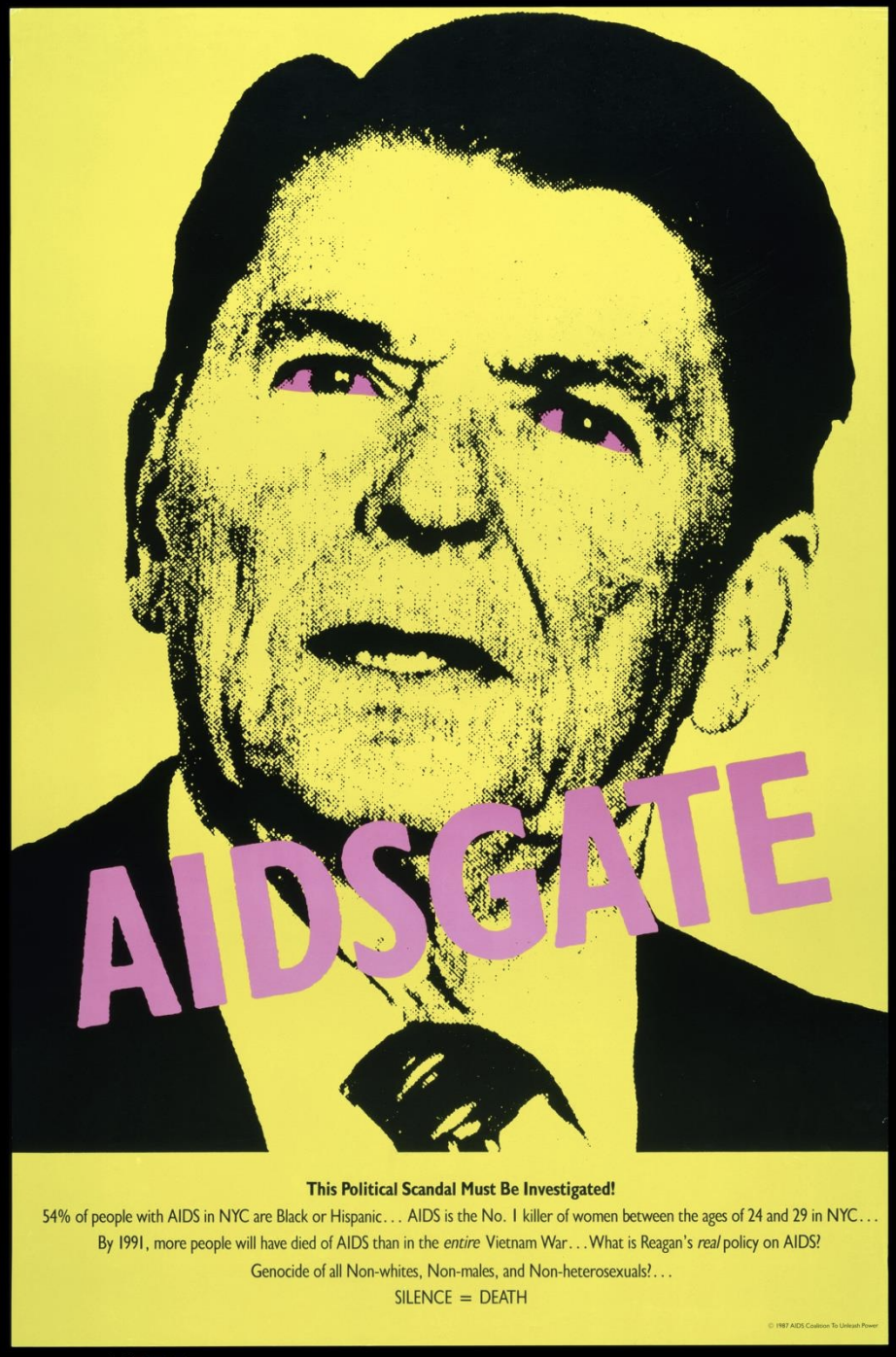
Silence = Death Project
by AIDSGATE
1987
Silence = Death Project by AIDSGATE, 1987, is a bold statement against the lack of government response to the AIDS epidemic. It uses the iconic pink triangle color to raise awareness for the LGBTQ+ community and fight against AIDS and discrimination.
The Silence = Death Project, created by the activist group AIDSgate, emerged during the height of the AIDS crisis in the 1980s as a bold statement against the lack of governmental response to the epidemic. Its relevance lies in its iconic use of the pink triangle symbol, a call for visibility, and a demand for urgent action, helping to galvanize the LGBTQ+ community and allies in the fight against AIDS and discrimination.

NAMES Project Memorial AIDS Quilt
by Cleve Jones & others
1987-present
NAMES Project Memorial AIDS Quilt by Cleve Jones, 1987, is a massive collaborative work commemorating the lives lost to the AIDS epidemic, with each panel representing a person who died. It played a powerful role in raising awareness and humanizing the epidemic while also serving as a memorial for the many people lost.
The NAMES Project Memorial AIDS Quilt, created by Cleve Jones and others, is a massive, collaborative work of art that commemorates the lives lost to AIDS, with each panel representing a person who died from the disease. Its relevance lies in its powerful role in raising awareness, humanizing the epidemic, and advocating for increased visibility and action, while also serving as a tool for mourning, healing, and activism.
Key Words to Use
https://docs.google.com/document/d/1mFxHwsXLttmouzfRsyfwMgp9-Ju0PkelZ1X9elNAzbE/edit?usp=sharing
Manifest Destiny, “The Indian Question,” leger drawings, emancipation, “The Contented Servant,” “The Vanishing Indian,” phrenology, eugenics, Social Realism, genre painting, Mexican muralism, working class, Modernism, Pueblo Modernism Santa Fe School, San Ildefonso Self-Taught Group, Harlem Renaissance, negritude, bricolage, Pan Americanism, Art Deco, Fine Art, Folk Art, ”Primitive Art,” Postmodernism, essentialism, Culture Wars, Salvage Paradigm, femmage, Chicano/a, appropriation